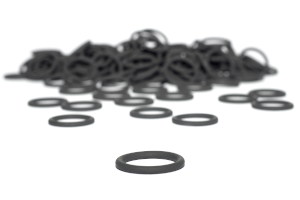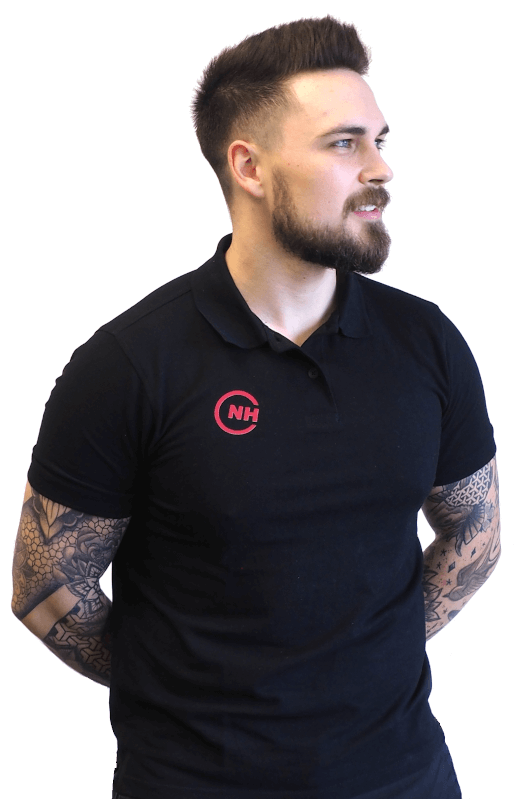NBR O-RINGS | MATERIALS SIMPLY EXPLAINED
What are NBR O-rings?
Alongside FKM or HNBR, NBR (nitrile butadiene rubber) is one of the most frequently used elastomers for sealing elements.
The material is characterized by advantageous mechanical properties and a broad resistance profile. The wide range of applications for these O-rings is limited only by their restricted suitability for high temperatures. But there is a solution for this too.
HNBR, hydrogenated nitrile butadiene rubber, extends the high-temperature range of NBR and is therefore suitable for even more demanding applications. However, many standard applications can be economically realized with NBR O-rings economically.
They are also known by manufacturer names such as Perbunan® or Europrene®.

Feature | Value |
|---|---|
ISO designation | NBR |
Trade names | Perbunan |
Chemical name | Nitrile butadiene rubber |
Media resistance | Medium media resistance |
Temperature resistance | -30°C to +120°C |
Standard color | Black |
Standard hardness | 70 Shore A |
Scope | Automotive industry, oil & gas, chemicals |
Production | Compression molding and injection molding |
Tolerances | DIN ISO 3601 |
Durability | 6 years |
NBR O-RINGS QUICK AND EASY TO REQUEST?
Almost any dimension available
Over 10,000 FKM dimensions available from stock
Offer received in record time
No minimum order values or minimum quantities
#1 The 5 most important advantages of NBR O-rings
- Attractive price-performance ratio
- Good cold resistance
- Tear and abrasion resistance
- Chemical resistance to mineral oil
- Available in various hardnesses and colors
NBR O-rings are suitable if the application requires pronounced flexibility at low temperatures. Sealing elements made of this material retain their elastic properties for a long time, even at falling temperatures.
Alternatives to NBR with similar low-temperature suitability are silicone, CR, EPDM or FKM, which must be selected for the individual application depending on their media resistance.
Even during static use, the machine parts to be sealed may move.
Changing pressure conditions also cause O-rings to move in the installation groove. This results in mechanical wear. However, NBR O-rings are characterized by their abrasion resistance are hardly susceptible to such weakening of the material.
They retain their mass and therefore not only maintain their sealing effect for longer. This makes NBR O-rings suitable even for dynamic applications a suitable option.
In addition, NBR has a low compression set. In this way, the O-ring returns to its original cross-section after prolonged deformation and can fill the sealing gap reliably close the sealing gap.
NBR is also the standard material for pneumatic and hydraulic applications. The O-rings benefit from their resistance to mineral oil-based products.
A comparison of the most important O-ring materials
Material | Temperature resistance | Chemical resistance | Elasticity |
|---|---|---|---|
NBR | -30°C to +120°C | Low | High |
HNBR | -30°C to +150°C | Medium | High |
EPDM | -45°C to +150°C | Medium | High |
SILICONE | -60°C to +200°C | Low | High |
FKM (VITON) | -25°C to +200°C | Medium | High |
FEP coated | -60°C to +200°C | High | Medium |
PTFE | -250°C to +250°C | High | Low |
FFKM | -40°C to +340°C | High | High |
#2 The 3 most common areas of application for NBR O-rings
Automotive industry
In combustion engines, strongly fluctuating temperatures occur during the operating phases. Sealing elements for these applications must cover temperature ranges between -40 and 180 degrees.
In addition to its resistance to SAE engine oils, the high temperature suitability of NBR is the decisive property for this area of application. For the highest temperature loads, alternative materials such as HNBR have more reserves.
Oil and gas industry
O-rings made of NBR are approved for use in gas-conducting systems. The approval of the O-rings in accordance with DIN EN 549 is decisive for this.
NBR O-rings play an important role in practice in this area. However, the O-ring materials HNBR, VMQ or FKM are also available to users as alternatives.
CHEMICAL INDUSTRY
The areas of application in chemistry and process engineering are highly diversified. Material selection and dimensioning of the O-rings are carried out with the best possible consideration of the installation situation and the requirement profile.
The aim is to minimize the risk of downtime in highly cross-linked production chains due to failing O-rings. NBR has its place here alongside many other materials. NBR O-rings are used in pressure systems, among other things.
This applies equally to static and dynamic applications.
#3 What is the media resistance of NBR O-rings?
Mineral oils and products based on them are found in almost all technical systems. They are used as hydraulic oils, fuels or lubricants, among other things. NBR O-rings exhibit good resistance in contact with these media. Thanks to the high abrasion resistance of NBR, this potential can also be utilized in practice.
NBR is resistant to
- Water
- Aliphatic hydrocarbons such as mineral oil, hydraulic oil or heating oil
- Diluted acids and bases
- Water-based hydraulic fluids
- Vegetable and animal fats
NBR is not resistant to
- Ozone and weather influences
- Polar solvents such as acetone
- Aromatic and chlorinated hydrocarbons
- Glycol-based brake fluid
When using NBR O-rings, the vulnerability of the material to ozone must be taken into account.
Even with improper storage in the ambient air can lead to deep cracks in the O-ring, causing the seal to fail prematurely. This is particularly problematic with pre-assembled seals made of NBR. The remedy is airtight storage in a relaxed state.
For particularly stressed O-rings, we recommend choosing a compound with special ozone protection agents. NBR also shows weaknesses when used in hot water and steam. Alternatively, HNBR offers a significant increase in resistance to ozone attack and for hot water applications.
The material is produced by hydrogenating NBR and also has an increased upper operating temperature.
#4 What is the temperature resistance of NBR O-rings?
In general, the temperature range of NBR O-rings is between -30 and 120 degrees.
The proportion of acrylonitrile in the compound determines the property profile of NBR O-rings.
The resistance to oil and fuels improves with increasing compound content. However, this has a negative effect on flexibility at low temperatures. Users must therefore decide on a priority when selecting the right NBR material.
O-rings made of HNBR, on the other hand, can withstand higher temperatures of up to 150 degrees.
It should be noted that the heat resistance of NBR O-rings in contact with water and air is lower than when used with mineral oil-based media. The continuous temperature limit for standard qualities is 70 degrees for water and 110 degrees for air.
#5 What are the mechanical properties of NBR O-rings?
- Very good abrasion resistance
- Suitability for dynamic applications
- Low Compression set
The good abrasion behavior and pressure resistance benefit NBR O-rings in static sealing.
Even if the machine elements move in relation to each other due to changing pressure conditions or external influences, for example, the sealing rings can bridge the changed sealing gap.
This also applies after the O-ring has been under high pressure for a long time. If the O-ring moves in the groove, this is unlikely to result in particles coming loose from its surface.
The combination of these properties makes NBR O-rings suitable for light dynamic applications, unlike most alternative materials.
#6 What do I have to consider when designing the groove of an NBR O-ring?
- Make groove design according to ISO 3601
- In the static case, ensure minimum compression of the cross-section of 6%
- Select lower compression for dynamic sealing
- Provide up to 6% expansion over the inside diameter of the groove for external pressure
- Allow for 1 to 3% compression on the outer diameter of the groove if pressure is applied from the inside
In the high-temperature range, the durability of NBR O-rings is strongly related to the cord thickness.
The background to this is that with larger cross-sections, the volume increases significantly more than the surface area. This reduces the capacity for mass transfer in relation to the mass of the O-ring. As a consequence, thicker cords slow down the ageing mechanism of NBR O-rings due to oxygen contact.
This consideration should be taken into account when dimensioning the O-rings.
What is important for mounting of NBR O-rings?
- Provide insertion slopes between 15 and 20 degrees
- Deburr drill holes, even if they are only passed over during assembly
- Round off sharp edges with a minimum radius of 0.1 to 0.3 mm
- Do not expand the inner diameter of the O-ring by more than 50% during installation
- Use suitable mounting aids such as mounting cones or silicone grease
- Avoid twisting the O-ring
#7 Further important information on NBR O-rings
Finally, we would like to answer a few questions that we are frequently asked in everyday life.
#7.1 What kind of material is NBR?
NBR (nitrile butadiene rubber) is an elastomer that is used in a wide range of applications. The chemical, oil & gas and automotive industries in particular use NBR in immense quantities, as NBR has an excellent price-performance ratio.
NBR is the standard material for O-rings.
#7.2 Where can I find the NBR data sheet?
You can easily view the data sheet for our NBR O-rings directly on our website and download it if you wish.
#7.3 What is NBR 90?
The term “NBR 90” refers to both the material (NBR) and the Shore hardness (90).
The standard hardness (Shore hardness) of NBR is 70 Shore A. Accordingly, 90 Shore O-rings are harder than the standard and are therefore only used at high pressures.
“I am convinced that we should share our knowledge with the world. I hope I have been able to answer all your questions. If you have any further questions, please feel free to contact us at any time. We will be happy to help you.”

Lord of the O-rings
Author of the sealing academy



